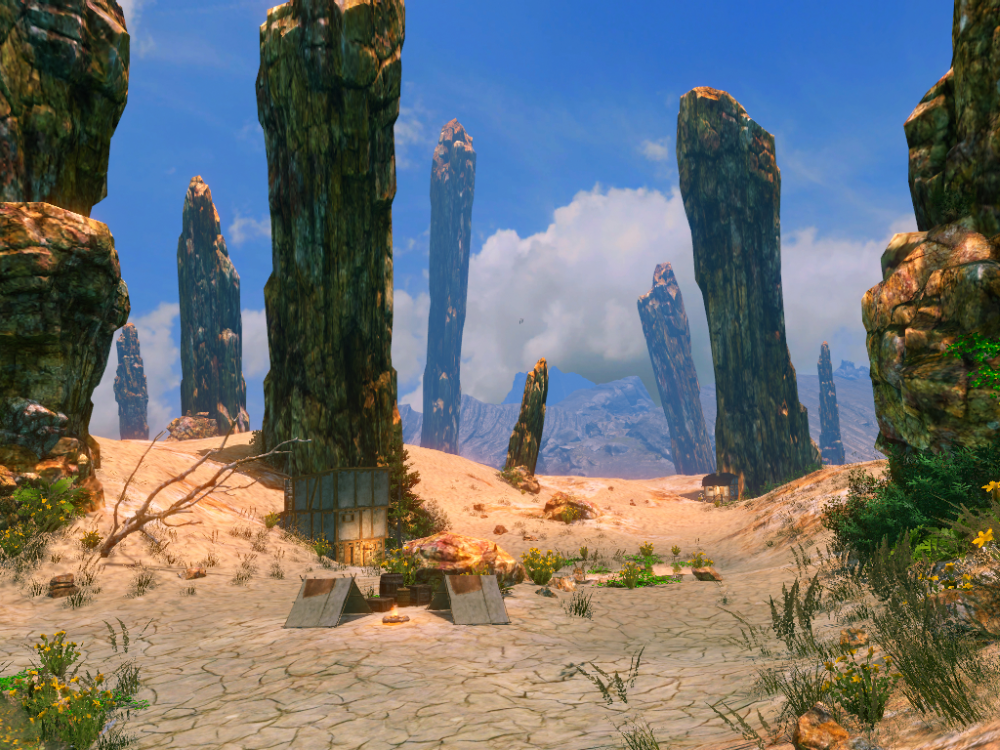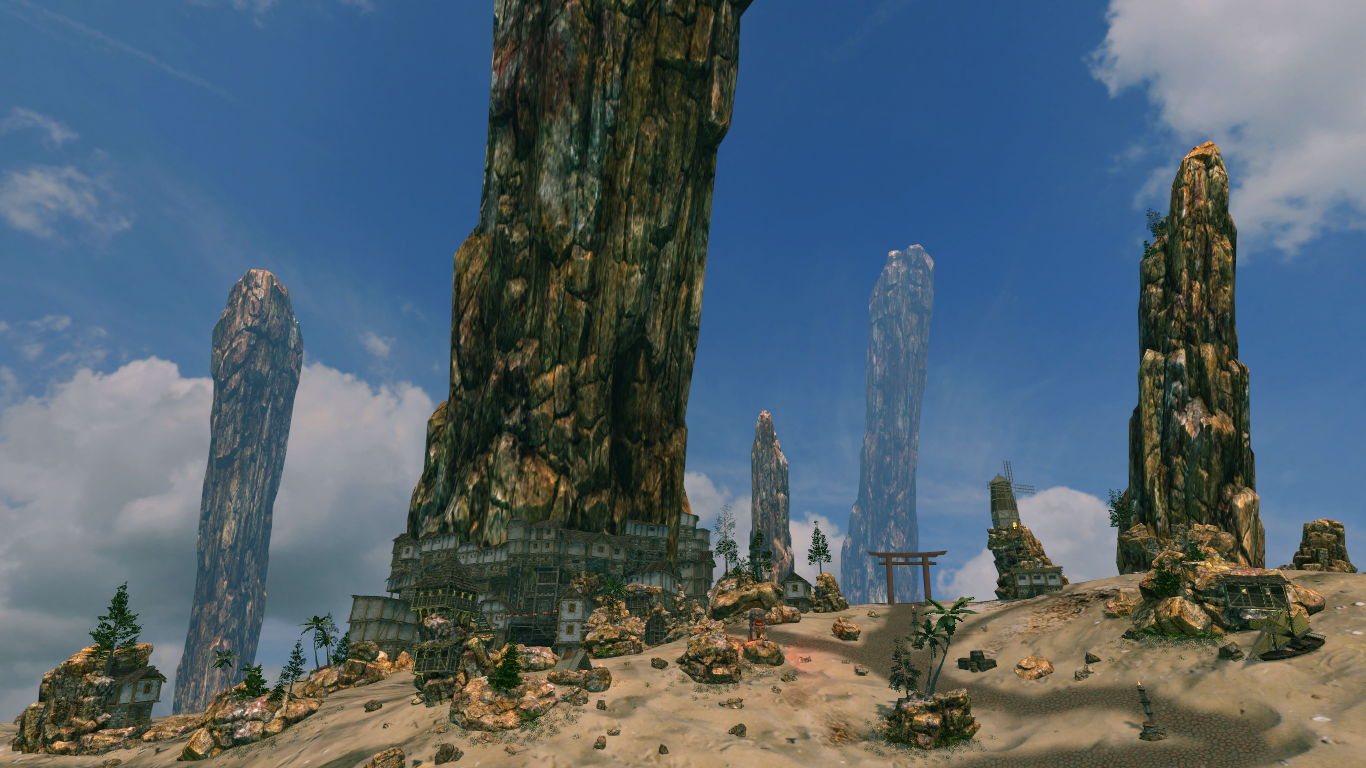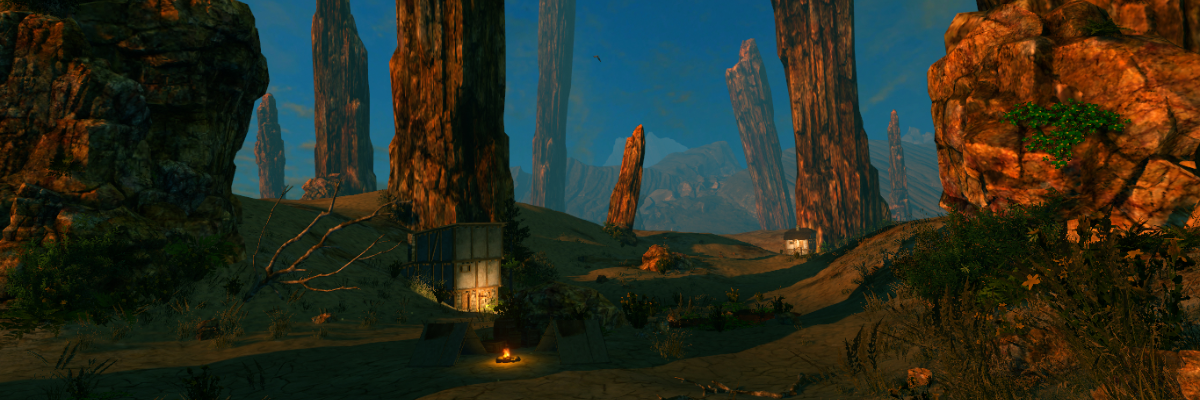Geography

Traveler's Rest by Doug Marshall
The Spires and their associated badlands biome cover a large section of the western side of Eren's southern lobe, merging with the arid crags of the Southern Range to the east and almost spanning to the Sunfire Sea in the west. The far western reaches of the Spires meet the Bay of Aethoel on their northwest edge, but are separated from the southern shores by a thin band of coastal forest and swamp. To the direct north, the steppes blend with scrublands and eventually fade into the Sonaran Plains, though the generally accepted northern border of the Spires is a combination of the
Ain Asura and the treeline of the Enele Basin jungle. Only one major river flows through the Spires: the
Ain Bennu, which splits into an upper and lower branch. However, the
Ain Vynda crosses the eastern edge of the region, cascading out of the mountains at Crown Valley and curving south through the badlands to meet the Ouroboran Ocean.
Geology
The Spires region was formed over millions of years of erosion during the
Equilibrian era, sculpting the sedimentary rock into a vast labyrinth of canyons, bluffs, buttes, and the Spires themselves. The uneven terrain and virtually nonexistent regolith render traversing the region quite treacherous on foot, and even air travel can be difficult during periods of low visibility. Though dangerous to navigate, the formations can be magnificent in both structure and color, composed of many alternating layers of sandstone, shale, and mineral oxides.
Climate
Though not uniform across the region, the Spires mostly preside over arid, desertic badlands. Temperatures toward the center of the Spires can soar upwards of 30°C in the daytime and drop to the single digits overnight, and the prevailing storm paths are obstructed by the peaks of the Southern Range, leaving large swathes of the Spires with less than 50 cm of precipitation a year. To the north, however, the storm systems that form over Cantera Bay reach the western side of the continent much more frequently, turning steppe into scrubland.
Wildlife
Fauna
The Spires are home to a modest assortment of animals that are well-adapted to the region's unique geology. Among these are various mustelids and rodents, ungulates such as wild goats and camelids, numerous species of reptiles, and a wide array of saurians, both avian and nonavian. Notable fauna of the Spires region include
sphynx,
cliffdivers,
phoenixes,
gryphons, and several species of
dragons.
Flora
A surprising diversity of plant and fungal life ekes out a living on and around the Spires, often employing creative solutions to the region's arid climate. Lichens and succulents abound in the sand and rock, accompanied by resilient grasses and shrubs. Trees are scarce, but a fair number of pine and palm species can be found in nooks where the thin clay soil has accumulated enough to support their root systems.
Inhabitants

Madfall by Doug Marshall
Though rather bleak and inhospitable in appearance, the Spires region is inhabited by an appreciable number of people, who are collectively called
Dustlanders. Most Dustlanders are
goblins, though
humans and the other
elven races are fairly common here. Less common are
harpies,
orcs, and
gorgons; newer arrivals from the other continents of Sphaera.
The population is mostly concentrated in the densely-packed settlements that spread up the sides of the Spires themselves like artificial ivy. The natural stone pillars are the best places to build, as they afford guaranteed shade from the sweltering desert sun, in addition to a more solid foundation than rubble and sand. These settlements are also almost exclusively found in close proximity to reliable sources of water –a rare necessity in the parched wastes– such as the rivers, the seasonal creeks, or the odd spring-fed oasis.
Bennu Kaupi is the largest urban area in the Spires, spanning multiple large spires on both sides of a bend in the Ain Bennu and several smaller buttes and bluffs on the outskirts.
Vyrtskard follows at a close second, built into both sides of a canyon pass at the upper fork of the very same river. Both of these cities, as well as several other smaller towns, serve as vitally important
skyship ports that service air routes which cross the badlands. There are few roads that run through the Spires, and those that do are often dangerous: rockslides, sandstorms, local fauna, and bandits make skyships and sandskiffs the obvious choices for transit across the region. Though the badlands are geopolitically a part of the
Héraðsríki –specifically, Lansur and Bennu provinces– the deeper, uninhabited reaches of Bennu Province are effectively lawless territory.






Comments